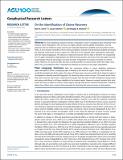| dc.contributor.author | Stone, Kane Adam | |
| dc.contributor.author | Solomon, Susan | |
| dc.contributor.author | Kinnison, Douglas E. | |
| dc.date.accessioned | 2019-11-05T16:34:18Z | |
| dc.date.available | 2019-11-05T16:34:18Z | |
| dc.date.issued | 2018-05 | |
| dc.date.submitted | 2018-05 | |
| dc.identifier.issn | 0094-8276 | |
| dc.identifier.uri | https://hdl.handle.net/1721.1/122774 | |
| dc.description.abstract | As ozone depleting substances decline, stratospheric ozone is displaying signs of healing in the Antarctic lower stratosphere. Here we focus on higher altitudes and the global stratosphere. Two key processes that can influence ozone recovery are evaluated: dynamical variability and solar proton events (SPEs). A nine‐member ensemble of free‐running simulations indicates that dynamical variability dominates the relatively small ozone recovery signal over 1998–2016 in the subpolar lower stratosphere, particularly near the tropical tropopause. The absence of observed recovery there to date is therefore not unexpected. For the upper stratosphere, high latitudes (50–80°N/S) during autumn and winter show the largest recovery. Large halogen‐induced odd oxygen loss there provides a fingerprint of seasonal sensitivity to chlorine trends. However, we show that SPEs also have a profound effect on ozone trends within this region since 2000. Thus, accounting for SPEs is important for detection of recovery in the upper stratosphere. Keywords: ozone; recovery; stratosphere; variability | en_US |
| dc.description.sponsorship | National Science Foundation (Grant ACD-1539972) | en_US |
| dc.language.iso | en_US | |
| dc.publisher | American Geophysical Union (AGU) | en_US |
| dc.relation.isversionof | http://dx.doi.org/10.1029/2018gl077955 | en_US |
| dc.rights | Article is made available in accordance with the publisher's policy and may be subject to US copyright law. Please refer to the publisher's site for terms of use. | en_US |
| dc.source | Prof. Solomon via Chris Sherratt | en_US |
| dc.title | On the Identification of Ozone Recovery | en_US |
| dc.type | Article | en_US |
| dc.identifier.citation | Stone, Kane A. et al. “On the Identification of Ozone Recovery.” Geophysical Research Letters 45, 10 (May 2018): 5158–5165 © 2018 American Geophysical Union | en_US |
| dc.contributor.department | Massachusetts Institute of Technology. Department of Earth, Atmospheric, and Planetary Sciences | en_US |
| dc.contributor.department | Massachusetts Institute of Technology. Department of Chemistry | en_US |
| dc.contributor.approver | Solomon, Susan | en_US |
| dc.relation.journal | Geophysical Research Letters | en_US |
| dc.eprint.version | Final published version | en_US |
| dc.type.uri | http://purl.org/eprint/type/JournalArticle | en_US |
| eprint.status | http://purl.org/eprint/status/PeerReviewed | en_US |
| dspace.orderedauthors | Stone, Kane A.; Solomon, Susan; Kinnison, Douglas E. | en_US |
| dspace.embargo.terms | N | en_US |
| dspace.date.submission | 2019-04-04T10:38:18Z | |
| mit.journal.volume | 45 | en_US |
| mit.journal.issue | 10 | en_US |
| mit.license | PUBLISHER_POLICY | en_US |

